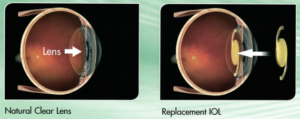An Upper Age Limit For LASIK?
Many patients want to know if there is an upper age limit for having LASIK laser eye surgery. While aging does affect the eye and the functioning of the eye, there is no absolute upper age limit for LASIK or PRK laser vision correction.It is, however, important to factor in how aging is affecting the rest of the eye when making a decision about having LASIK or PRK.
How Aging Affects Vision
On the lower end of the age spectrum, it is recommended to wait to have LASIK until the eye has stopped growing. For many people, this occurs by age 18 and the FDA recommends waiting until 18 years or older to have LASIK, although pediatric LASIK can be performed in certain situations to help minimize the impact of lazy eye in children. Some people’s eyes, however, are still growing at age 18 and they should wait until their eyes are stable in their glasses or contact lens prescription for at least one year before proceding with laser vision correction. Almost everyone has stabilized by the time they reach 30 years old, although there are even a few exceptions to this. It is important for patients in their twenties to know that LASIK will not stop future changes from happening, rather the goal of laser eye surgery rather is to “reset” the vision back to 20/20 without glasses or contacts. If the eye is still growing and changing, LASIK will not stop those changes that were destined to happen anyway. As aging continues past age 40, the lens of the eye, which sits deep inside the eye and is not affected by LASIK, will start to get physcially stiffer, making it harder and harder to focus up close – a process called “presbyopia” (Greek for “aging of the eye”). Presbyopia continues year after year until the early 60’s, at which time the lens becomes completely stiff and is unable to focus up close at all. After the lens becomes completely stiff, the next major step in the aging of the eye is that the lens starts to become cloudy and ultimately develop a cataract, which is a cloudiness of the lens that blocks vision. When someone gets a cataract, the only definitive treatment is to remove the lens surgically and put a clear replacement lens called the “implant” or “intraocular lens” in its place. When the implant is put in the eye, the patient’s prescription can be built in to the implant to correcct the patient’s prescription.
Aging In A Woman’s Eye, Menopause And LASIK
Besides these changes of aging, there are other important changes of aging. Some of these changes are specific to women. There are estrogen receptors in the human cornea and during pregnancy, a woman’s prescription can actually change in the presence of very high levels of estrogen, usually becoming more nearsighted. Typically — but not always — the prescription returns to its baseline after pregnancy and after nursing are completed. It is recommended to avoid LASIK or PRK during pregnancy and nursing, and to either have laser eye surgery surgery before pregnancy or to wait until 8 weeks after nursing stops to have LASIK or PRK laser vision correction. If the patient had laser eye surgery before pregnancy and the vision does not return to its baseline after pregnancy — which is rare — the previous laser eye surgery can be “touched up” to adjust to the new post-pregnancy vision. Generally this is not necessary. Going further down the aging stream, the average age of menopause is 52 years old, but the average age of “pre-menopause” or “peri-menopause” is 45 years. During peri-menopause and, even more so, at the time of menopause and thereafter, a woman’s eye typically becomes more dry, often to the point of producing menopausal dry eyes. This is because the lowered level of estrogen stimulates a low grade level of inflammation on the surface of a woman’s eye and the inflammation makes the oil and tear producing glands work less effectively and also creates a self-feeding inflammatory cycle on the surface of the cornea. In menopausal patients, extra treatments of dry eye may be helpful before having LASIK.
Factoring Aging into Decisions About LASIK: Presbyopia And Reading Glasses
Althought there is no maximum age for performing LASIK, all of these aging changes need to be kept in mind. For example, if a patient has LASIK at a presbyopic age and both eyes are set for the best possible distance vision, that patient will need reading glasses. However, that patient would also have needed reading glasses at that age if they were born with perfect eyesight rather than obtaining their perfect eyesight from LASIK. For patients in the presbyopic age range, one option to help lessen dependency on reading glasses is to create LASIK monovision or blended vision in which the dominant eye is set for distance vision and the non-dominant eye is set for closer vision. The two eyes working together can give good distance and near vision. Other aging changes should make one be cautious about having LASIK. If a patient has a cataract, having LASIK will potentially improve the vision by correcting the patient’s prescription, but it will not do anything to help treat the cataract and the vision will still be limited by the cloudiness of the cataract. And, since the cataract is not treated, it will only conitue to get worse as it would have anyway. For this reason, if a patient has cataracts, having cataract surgery is a more appropriate choice than having LASIK or PRK laser vision correction. If a patient has trivial levels of cloudiness in their lens, it can still be reasonable to do LASIK or PRK with the knowledge that eventually the patient likely will need catarct surgery down the road. However, at an even older age, if a patient still needs a prescription pair of glasses to see after cataract surgery has been done and the clear implant has been placed in the eye, then LASIK or PRK can be performed to touch up the cataracts surgery’s results even if the patient is in their 80s or 90s. In other words, LASIK or PRK laser vision correction can be performed before catarct surgery or after catarct surgery if needed.
Refractive Lens Exchange (RLE): An Alternative To LASIK
One alternative to LASIK or PRK laser vision correction is refractive lens exchange (RLE), a procedure which is essentially cataract surgery performed on an eye before it has a visually significant cataract. RLE typically is an option for patients who are in the “pre-cataract” phase of life — typically in the mid 50s and older. The logic of RLE is that by replacing the lens with a clear implant, the vision can be corrected and the patient will never develop a cataract, meaning the patient can have one surgery and be done. The downside to RLE is that it carries higher risk (it is significantly more invasive in that it goes inside the eye, unlike LASIK or PRK) and also carries lower accuracy than the latest versions of customized wavefront laser vision correction. Many patients opt for laser vision correction in this age range with the notion that they can have cataract surgery at a later stage of the aging process when true cataracts actually develop.




